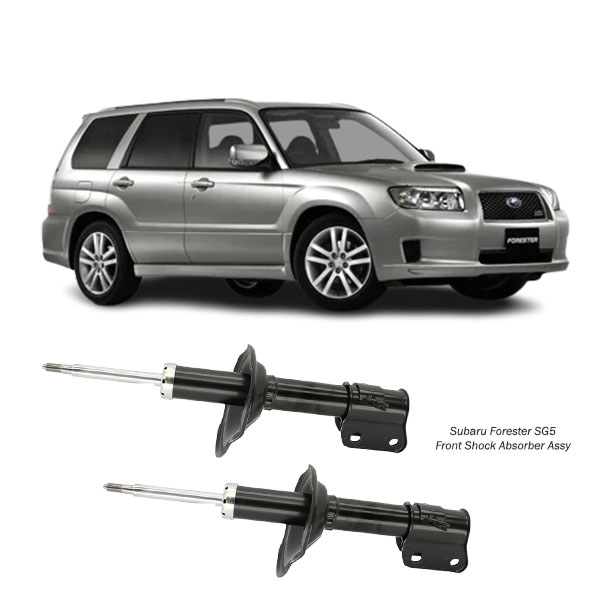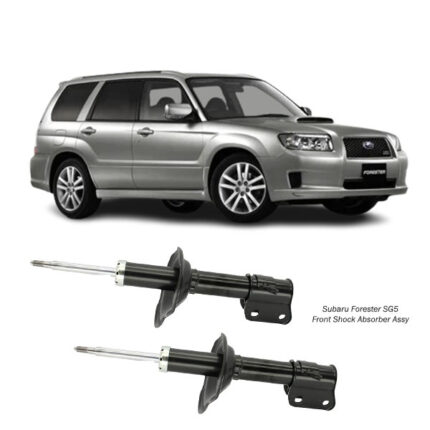Get Subaru Forester SG5 Front shock Absorber Assy 334343 in Kenya
The front shock absorber assembly is a vital component of the suspension system that plays a critical role in a vehicle’s stability, comfort, and handling. It helps control the impact and rebound movement of the vehicle’s front wheels, maintaining tire contact with the road surface at all times. A properly functioning front shock absorber ensures a smooth ride, precise steering response, and effective braking performance.
This assembly typically includes the shock absorber itself, coil spring, strut mount, dust boot, and sometimes a spring seat or bearing. Together, these components absorb and dampen road shocks, reduce vibrations, and ensure optimal wheel alignment under dynamic conditions.
Purpose of the Front Shock Absorber Assembly
The primary purpose of a shock absorber is to manage the suspension’s movement and to dissipate the energy generated when a vehicle travels over uneven terrain or during acceleration, braking, and cornering. While springs support the vehicle’s weight and absorb initial impacts, shock absorbers regulate the bounce and oscillation of these springs.
The front shock absorbers are especially critical because they support the steering mechanism and help maintain directional control of the vehicle. Without effective damping, the front wheels may bounce excessively or lose contact with the road, compromising handling, stability, and safety.
Components of a Front Shock Absorber Assembly
-
Shock Absorber (Damper)
This is the core component that dampens suspension movement. It contains hydraulic fluid and valves that absorb and dissipate energy from vertical wheel motion. -
Coil Spring (in strut-type assemblies)
Works in tandem with the damper to support the vehicle’s weight and absorb road impacts. -
Strut Mount
Connects the shock absorber to the vehicle’s chassis. It may include a bearing to allow smooth rotation for steering. -
Dust Boot
Covers the piston rod and protects it from dust, dirt, and moisture, extending the lifespan of the shock. -
Bump Stop
Prevents metal-to-metal contact if the suspension bottoms out. -
Spring Seat
Holds the coil spring in place and ensures proper tension and alignment.
Advantages of a Good Front Shock Absorber Assembly
-
Improved Ride Comfort
A good shock absorber assembly smooths out road imperfections, potholes, and bumps, ensuring a comfortable driving experience. -
Better Vehicle Control
Maintains consistent tire-to-road contact, ensuring more predictable handling and steering response. -
Shorter Braking Distance
Prevents front-end dive during braking, which helps distribute braking force evenly and reduces stopping distances. -
Enhanced Tire Lifespan
Proper damping prevents uneven tire wear by minimizing excessive bounce and maintaining optimal alignment. -
Increased Safety
Reduces body roll, nose dive, and rear squat, all of which contribute to safer handling in emergencies or during sharp turns. -
Minimized Body Vibrations
Reduces noise, vibration, and harshness, especially at higher speeds or on rough roads. -
Better Cornering Stability
Absorbs lateral forces during turns, improving grip and reducing the risk of skidding or rollover.
Disadvantages of a Worn-Out or Faulty Shock Absorber Assembly
-
Decreased Ride Comfort
A worn-out assembly allows excessive bouncing and jolting, making the ride uncomfortable for occupants. -
Poor Steering Response
Faulty shocks reduce control over the front wheels, making steering feel loose or unresponsive. -
Increased Stopping Distance
A bad shock absorber allows excessive weight transfer during braking, which can increase stopping time and distance. -
Uneven Tire Wear
Excessive up-and-down motion causes irregular wear patterns, leading to premature tire replacement. -
Suspension Noise
A damaged assembly may produce clunking, rattling, or squeaking noises, especially on bumpy roads. -
Hydraulic Fluid Leaks
Leakage from the shock absorber body is a clear sign of internal failure and reduced damping performance. -
Increased Wear on Other Components
Suspension bushings, springs, and mounts can deteriorate more rapidly when the shock absorber is not functioning correctly.
Signs of a Failing Front Shock Absorber Assembly
-
Excessive Bouncing
After hitting a bump, if the vehicle continues to bounce several times, it indicates weak or ineffective shock absorption. -
Nose Diving While Braking
The front end dipping significantly when applying brakes is a classic sign of worn-out front shocks. -
Poor Cornering Stability
Excessive body roll or sway during turns suggests that the front shocks are not controlling lateral motion adequately. -
Steering Instability
A drifting or wandering sensation while driving on straight roads could point to shock absorber issues. -
Fluid Leakage
Visible hydraulic fluid leaking from the shock body signals internal seal failure. -
Uneven Tire Wear
Cupping or scalloping on tire tread often results from worn-out shocks failing to keep the tire planted evenly. -
Knocking or Clunking Sounds
Worn shock mounts or damaged internal components can produce noise when driving over imperfections.
How to Replace a Front Shock Absorber Assembly
Tools and Equipment Required:
-
Jack and jack stands
-
Lug wrench
-
Socket and ratchet set
-
Spring compressor (if dealing with coil-over struts)
-
Torque wrench
-
Penetrating oil
-
Safety gloves and goggles
Step-by-Step Guide:
-
Prepare the Vehicle
Park on a level surface, engage the handbrake, and chock the rear wheels. Loosen the front lug nuts. -
Lift and Secure
Use a jack to lift the front of the vehicle and place it securely on jack stands. Remove the wheels. -
Access the Shock Absorber Assembly
Locate the top and bottom mounting bolts. Use penetrating oil if bolts appear rusted or corroded. -
Remove Mounting Bolts
Unbolt the lower shock mount and then the upper strut mount or bolts holding it to the strut tower. -
Extract the Assembly
Carefully remove the entire shock absorber assembly from the vehicle. If a coil spring is integrated, compress it with a spring compressor before proceeding further. -
Install the New Assembly
Position the new or rebuilt shock absorber assembly in place. Hand-tighten the mounting bolts to hold it securely. -
Torque the Bolts
Use a torque wrench to tighten all fasteners to the manufacturer’s specifications. -
Reinstall Wheels
Place the wheels back on and tighten lug nuts by hand. Lower the vehicle and torque the lug nuts in a star pattern. -
Test Drive
Drive slowly to check for proper ride height, stability, and absence of noise or vibrations.
Follow us on Facebook for more parts.




